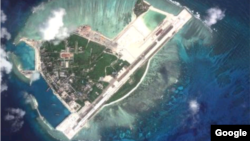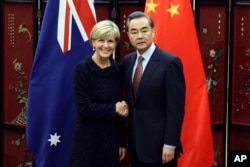U.S. Secretary of State John Kerry has criticized China and said there should be "no militarization" of the South China Sea, following news that Beijing has deployed surface-to-air missiles on a disputed island it controls in the strategic waterway.
"We have said repeatedly with respect to China that the standard that should be applied to all countries with respect to the South China Sea is no militarization," Kerry said Wednesday. He specifically noted that Chinese President Xi Jinping vowed not to militarize the sea when he visited Washington last year and met with President Barack Obama.
"But there is every evidence, every day that there has been an increase of militarization of one kind or another. It is of serious concern," Kerry said. "We have had these conversations with the Chinese and I am confident that over the next days we will have a further very serious conversation on this."
WATCH: US Secretary of State John Kerry on China's latest move
At the Pentagon, U.S. officials told VOA the Chinese missile deployment is a "complicating aspect" of the territorial disputes involving several countries that border the South China Sea. The U.S. is watching the situation closely, the source added.
Another American official told VOA the Chinese missiles are part of an HQ-9 air defense system, which has an operating range of 200 kilometers (125 miles).
The Chinese missiles' arrival on Woody Island, one of the tiny islands in the area that China has greatly enlarged through dredging and construction work, was first reported by American broadcaster Fox News, based on satellite images provided by a civilian company. The images appear to show two batteries of eight surface-to-air missile launchers and a radar system.
VOA's Pentagon correspondent was told "there is no reason to doubt the imagery."
The missile issue erupted as Obama wrapped up a landmark summit with Southeast Asian leaders in California.
Obama urged all parties to exercise restraint in the region and halt the militarization of disputed maritime areas.
US and Taiwan confirm
A U.S. defense official later confirmed the deployment, as did Taiwan’s Defense Ministry spokesman Major General David Lo.
"Interested parties should work together to maintain peace and stability in the South China Sea region and refrain from taking any unilateral measures that would increase tensions," Lo said on Wednesday.
Woody Island (or Yongxing Island as it is known in Chinese and Phu Lam in Vietnamese) is the largest of the Paracel Islands and is located in the northernmost part of the South China Sea, east of the central Vietnamese city of Da Nang. Woody Island has been under China’s control since 1956, and is a prefecture level city of the southern Chinese province of Hainan.
The island is also claimed by Vietnam and Taiwan.
Chinese reaction
China’s Foreign Minister Wang Yi told reporters Wednesday that Western media should pay more attention to the lighthouses and meteorological facilities China is building in the South China Sea.
During a press conference following a meeting with his visiting Australian counterpart Julie Bishop, he did not deny reports about the missile deployments, but called them “an attempt by certain western media to create news stories.”
Wang did note what he called China’s right to limited and necessary self-defense facilities on its islands and reefs.
"This is consistent to self-preservation and self-protection that China is entitled to under international law. So there should be no question about that," Wang said.
Chinese claims
China’s claim to almost all of the South China Sea and massive reclamation of formations further south has been a growing source of concern among its neighbors in the region, even as Beijing works feverishly to expand trade ties. In recent years, China has beefed up efforts to build runways and artificial islands to bolster its territorial claims.
Beijing has repeatedly said that it does not seek to militarize the South China Sea, but it has increasingly voiced concerns about U.S. freedom of navigation missions in the region, at sea and in the air.
What the missile deployment may mean
Alexander Huang, an assistant professor at Taiwan’s Tamkang University, said the deployment was sending a telling, albeit contradictory signal about China’s future intentions in the South China Sea.
Huang said the development sends a contradictory signal because China has repeatedly said that it would not militarize the disputed islands. Adding that while the dispute over Woody Island is largely between China and Vietnam and does not necessarily involve the United States, it “may serve as a prelude or indicator for the future militarization of the Spratlys.”
“China is under tremendous pressure right now with the conference in Sunnylands and the U.S.-[South] Korean discussion over the THAAD deployment,” he added.
US-ASEAN summit
As President Barack Obama wrapped up a two-day summit with the leaders of the Association of Southeast Asian Nations, the first on U.S. soil, he said the two affirmed during their meeting their “strong commitment to a regional order where international rules and norms – and the rights of all nations, large and small – are upheld.”
He also said that during the meeting, the US and ASEAN leaders “discussed the need for tangible steps in the South China Sea to lower tensions, including a halt to further reclamation, new construction and militarization of disputed areas.”
Still, how the United States and ASEAN countries may respond is unclear. While ASEAN countries may genuinely want closer ties with the United States, they are also heavily and increasingly reliant on booming trade with China.
And if the United States wishes to respond, the tougher question is what could Washington do to get China to change its behavior.
Freedom of navigation
Freedom of navigation actions by the U.S. Navy have not made Beijing to change its behavior, noted Ross Darrell Feingold, a Taipei-based senior advisor at DC International Advisory, a political risk consultancy.
Perhaps more important is what the action says about China’s ability to manage significant issues simultaneously, Feingold added.
“There is the aftermath of the North Korea missile test and nuclear test, the ASEAN Summit, significant political change in Taiwan, ongoing domestic challenges – economy, corruption investigations –yet the Chinese leadership remains confident it can, at the same time, manage the international reaction to its missile deployment,” he said.
State Department correspondents Pamela Dockins and Nike Ching and VOA Pentagon correspondent Carla Babb contributed to this report

















